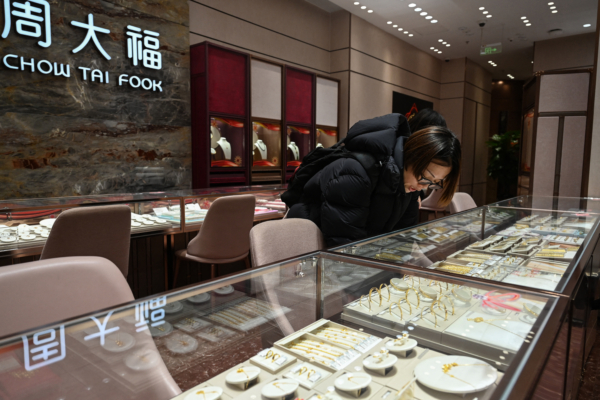Despite the continuous rise in gold prices, the Chinese gold retail industry is facing a harsh winter. China’s largest jewelry retailer, Chow Tai Fook, revealed in its 2025 financial report that it had closed a net of 905 stores on the mainland, averaging 2.5 store closures per day. Additionally, brands like Chow Sang Sang, Chow Tai Seng, and Luk Fook have also significantly reduced their store networks this year.
On November 6th, according to reports from The Paper and Jiemian News, the latest financial data from Chow Tai Fook showed that its mainland retail stores increased from 4,452 in 2021 to 7,407 in 2024, but then decreased to 6,501 in 2025 after closing 905 stores. By the end of September, the company had a total of 6,041 retail stores, a decrease of 603 from the end of March, signaling a major adjustment in the brand’s expansion strategy.
Other jewelry brands are also facing similar challenges.
As of September 30, 2025, Chow Sang Sang had a total of 4,675 terminal stores, a net decrease of 560 compared to the same period last year and 333 fewer than at the beginning of the year, with franchise stores accounting for most of the closures.
During the first half of 2025, the Chow Sang Sang Group reduced a net of 74 various brand stores in mainland China, with the main brand “Chow Sang Sang” closing 62 stores.
By reducing 280 franchise stores in the first half of 2025, Luk Fook saw a decrease in its store count. The Luk Fook Group had a total of 3,113 stores worldwide by the end of September, with a net decrease of 49 stores during the quarter, including 51 in the mainland market.
The wave of store closures exhibits distinct regional and business model features. Chow Tai Fook’s data indicates that the retreat of gold shops is mainly concentrated in franchise stores in third and fourth-tier cities. The semi-annual report data from Chow Sang Sang further illustrates this trend: there was a net decrease of 441 gold stores in third and fourth-tier cities and below compared to the same period last year, showing a severe decline.
Despite the seemingly positive impact of rising gold prices on gold shops, the reality is quite the opposite. Data from the World Gold Council shows a significant contraction in gold demand for “jewelry consumption” since the fourth quarter of last year. At the same time, demand for “gold ETFs and similar products” for investment purposes surged from 18.7 tons to 221.7 tons, indicating that market excitement belongs to investors rather than gold shop consumers.
The high gold prices have exerted multiple pressures on franchisees. They are unwilling and unable to stockpile large amounts of gold inventory at high prices, as it not only ties up significant funds but also exposes them to the risk of potential losses from gold price fluctuations. Chow Sang Sang’s financial data confirmed this dilemma: franchise business revenue decreased by a staggering 56.34% in the first nine months of 2025 compared to the same period.
Chow Sang Sang stated in its financial report that the continuous high gold prices have significantly inhibited retail consumption of gold jewelry, making consumers more rational and cautious in their gold jewelry spending, especially for non-essential consumption. With gold prices back above 1,200 yuan per gram, many consumers are choosing to wait for price drops or turning to alternative purchases. Even for essential purchases like weddings, couples may opt for lighter, smaller styles or compromise on brands and craftsmanship to control their total budget.
On November 1, the Chinese Ministry of Finance and the State Administration of Taxation issued the “Announcement on Gold-related Tax Policies” for implementation. For non-investment gold enterprises, the reduction in input tax deductions (from 13% to 6%) has increased costs, with an expected cost increase of over 60 yuan per gram.
The market reacted swiftly to the new policy. Chow Tai Fook reported prices of 1,198 yuan per gram on November 1, 1,259 yuan per gram on November 3, and 1,265 yuan per gram on November 4. The Shuibei market in Shenzhen also rose from 931 yuan per gram on November 1 to 991 yuan per gram on November 4.
Industry insiders anticipate that under the backdrop of the new gold tax policy, the retail market may face further suppression, and the previously more active investment demand for gold bars may also be affected. The trend of store closures is expected to worsen as the gap between selling and repurchase prices widens, diminishing the value preservation and appreciation effect.
Furthermore, as gold prices surpass 1,000 yuan per gram, maintaining price competitiveness on e-commerce platforms will lead to a decrease in gross profit margins. Coupled with new tax regulations, e-commerce platforms are expected to face resistance in their future development, possibly leading to further market concentration, with only large e-commerce platforms with sufficient financial strength benefiting.
When profitability becomes challenging, closing stores becomes the only option for franchisees. It is expected that the operations of branded gold stores will continue to be under pressure, and industry consolidation may accelerate.

